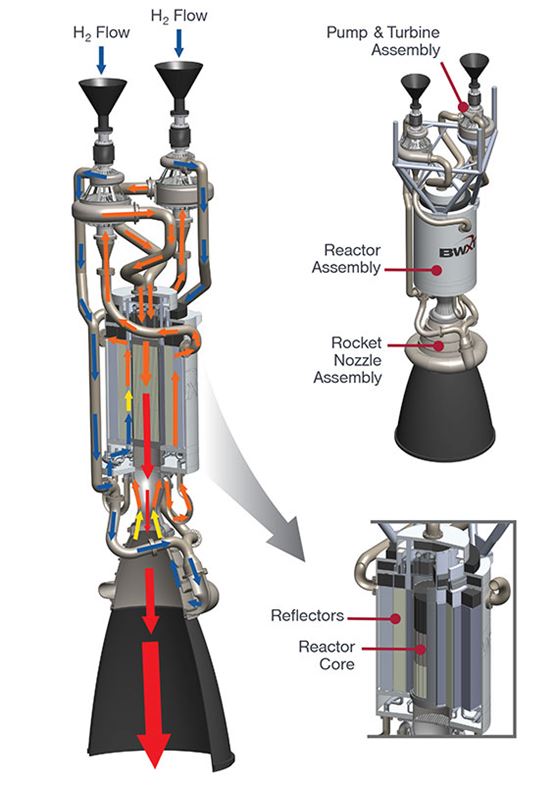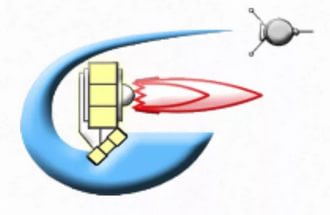أمريكا و روسيا و دول النادي الفضائي تعلم أن المحرك الوحيد القادر على إيصال البشر لكواكب بعيدة يجب أن يكون نوويا لكن الأمر خطير و لم يتم معرفة تأثيرات الفضاء الخارجي على محرك من هذا النوع و ما يمكن ن يشكله من خطر على الصاروخ أو المركبة
المهم من هذا أن أمريكا في سنة 1950 كان لديها مشروع لمحرك نووي تحت اسم المشروع أوريون
لمزيد من التفاصل اقرأ التالي
Project Orion has to be the most audacious, dangerous and downright absurd space programme ever funded by the US taxpayer. This 1950s design involved exploding nuclear bombs behind a spacecraft the size of the Empire State Building to propel it through space. The Orion’s engine would generate enormous amounts of energy – and with it lethal doses of radiation.
Plans suggested the spacecraft could take off from Earth and travel to Mars and back in just three months. The quickest flight using conventional rockets and the right planetary alignment is 18 months.
There were obvious challenges – from irradiating the crew and the launch site, to the disruption caused by the electromagnetic pulse, plus the dangers of a catastrophic nuclear accident taking out a sizable portion of the US. But the plan was, nevertheless, given serious consideration. Project Orion was conceived when atmospheric nuclear tests were commonplace and the power of the atom promised us all a bright new tomorrow. Or oblivion. Life was simpler then.
In the early 1960s, common sense prevailed and the project was abandoned, but the idea of nuclear-powered spaceships has never gone away. In fact there are several in the cold depths of space right now.

Nasa's Nerva project also investigated the use of nuclear engines in space (Adrian Mann)
The
Voyager space probes, currently heading beyond the bounds of the Solar System, and the
Cassini spacecraft in orbit around Saturn are fitted with nuclear power plants. These Radioisotope Thermoelectric Generators (RTGs) rely on the natural decay of plutonium to generate heat, which is then converted into electricity.
With no moving parts, RTGs are not nuclear reactors and can only generate a few hundred watts of power (the equivalent of a bright lightbulb). But as ambitions for missions deeper into our solar system grow, much larger spaceships propelled by more powerful nuclear generators are back on the agenda.
“Orion was a visionary project,” says Kelvin Long, physicist, engineer and head of the
Initiative for Interstellar Studies. “People who are excited about this stuff don’t live in the present, we live in the future.”
Long’s immediate future involves helping to design a starship – a robotic craft that could travel at high speed beyond our Solar System to other nearby stars. A starship travelling at thousands of kilometres per second could reach Mars in weeks, the outer solar system in months and other star systems in years. Long is not alone. There are several other programmes underway, including the
100 Year Starship project backed by the
US military research agency, Darpa.
To achieve this goal, the ships will need much more powerful propulsion systems than conventional chemical rockets or solar-powered probes. “It’s all about generating enormous amounts of energy,” says Long. “You can get much more efficient power generation from nuclear systems, such as fission or fusion.”

In the 1970s, the Daedalus project combined a nuclear fusion engine with helium fuel cells (Adrian Mann)
Fission involves splitting atomic nuclei in a controlled chain reaction to produce energy. Conventional nuclear power stations and the generating plants on nuclear submarines and ships use the technique to make electricity. It is a well established, but not incident-free, science. In the fusion process, on the other hand, the nuclei of atoms are forced together to release energy. It is what powers the Sun, and the hydrogen bomb.
“Fusion produces much more energy, in terms of bang for your buck, compared to fission-based systems,” says Long, explaining why his group’s starship designers favour fusion propulsion. “We know it’s a very efficient process. If you can do it you can produce a power generation system which will move you outside the Solar System and you don’t have to come back for more rocket fuel.”
Power challenge
However, as anyone who has followed the field knows, despite the multi-billion-dollar global effort that has gone into fusion research over the past half century, no one has yet built a fusion reactor that produces more energy then you put in. There is an in-joke among fusion engineers (and their journalist followers) that a viable fusion power plant
is always 30 years away.
Undeterred, various concepts for fusion engines have been proposed. One, funded by Nasa, involves a contained atomic reaction that generates a focused beam of charged particles to push the starship along. Apart from the enormous thrust such a system could generate – well in excess of conventional rockets – as you travel around the cosmos you could tap into a ready supply of suitable fuel, such as helium 3.
“There’s helium 3 in the gas giants like Jupiter, absolutely loads of it,” says Long. “You could mine it with huge balloons that you drop into the atmosphere, separate out the helium, load it into your starship and away you go.” It seems that no problem is too big for those who live in the future.

In the film 2001: A Space Odyssey, the Discovery's design kept the nuclear engines far away from living quarters (MGM)
Most 21st-Century starship designs owe a great deal to the
Daedalus interstellar craft, conceived by members of the British Interplanetary Society in the 1970s. Assembled in orbit, like the International Space Station (ISS), and a similar size to Orion, the concept starship was powered by a fusion engine surrounded by bulbous tanks of helium fuel.
But even assuming all this is doable, there remains one particularly sticky problem. It’s the same issue that faced the designers of Project Orion back in the 1950s. You can build and power-up your fusion engine in space to avoid nuclear fallout, but how do you protect your astronauts from dying of radiation sickness?
The Orion solution was to put thick metal or liquid shielding between crew and nuclear material. The latest concepts suggest a better idea might be to build long thin ships, where the engine is several hundred metres away from the habitation modules. Not unlike the spaceship in
2001: A Space Odyssey.
If a viable fusion reactor can be developed, Long reckons we could we see a nuclear-powered ship heading out of our immediate cosmic neighbourhood to the stars and planets beyond within the next century. “We would like to see humanity moving outwards and following the pioneers and dreams of the past,” he says. “We feel we’re working towards a future that’s good for humanity.”
Project Orion may have been ill-conceived, foolhardy and environmentally irresponsible, but nuclear power could yet be a tool to take humans to the stars.







